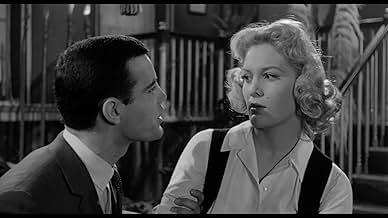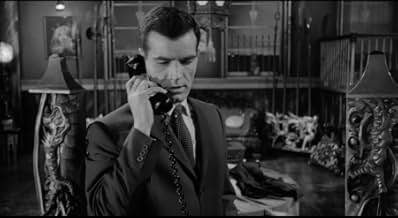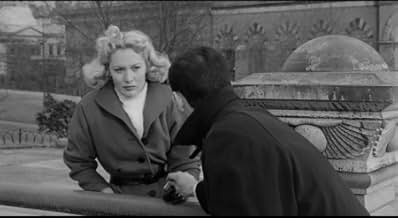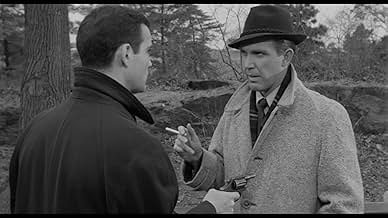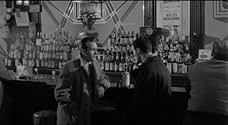Adicionar um enredo no seu idiomaA detective investigating the murder of a heroin addict discovers that there is a connection between the junkie and his fiancee, who is his boss' daughter.A detective investigating the murder of a heroin addict discovers that there is a connection between the junkie and his fiancee, who is his boss' daughter.A detective investigating the murder of a heroin addict discovers that there is a connection between the junkie and his fiancee, who is his boss' daughter.
- Direção
- Roteiristas
- Artistas
- Direção
- Roteiristas
- Elenco e equipe completos
- Produção, bilheteria e muito mais no IMDbPro
Avaliações em destaque
United Artists dumped this lousy movie, understandably since it lacks any entertainment value. As the title suggests, there was exploitation movie material to be mined here, but one-shot movie director Gene Milford (whose day job was film editing) delivered a deadly dull stinker with a no-name cast.
Writing credits are strictly A-list: screenplay by Harold Robbins early in his career, from an Ed McBain novel by Evan Hunter. But they have no feel for the genre. It plays like a reject episode of TV's "Naked City" series, with on-location photography plus chintzy studio interiors.
Cops are played by Robert Lansing and John Astin, also having career off-days. Heroine (who is hooked on perhaps heroin?) Kathy Carlyle is good looking but an instant flop -her only other movie was a routine Charles Bronson war picture.
The title character played by Felice Orlandi is a bore -instantly one-note evil. Addiction then and now is a surefire formula for drama, but Robbins, unlike his future amazing success with so many hit novels like "The Carpetbaggers", comes up with nothing but dullness.
Writing credits are strictly A-list: screenplay by Harold Robbins early in his career, from an Ed McBain novel by Evan Hunter. But they have no feel for the genre. It plays like a reject episode of TV's "Naked City" series, with on-location photography plus chintzy studio interiors.
Cops are played by Robert Lansing and John Astin, also having career off-days. Heroine (who is hooked on perhaps heroin?) Kathy Carlyle is good looking but an instant flop -her only other movie was a routine Charles Bronson war picture.
The title character played by Felice Orlandi is a bore -instantly one-note evil. Addiction then and now is a surefire formula for drama, but Robbins, unlike his future amazing success with so many hit novels like "The Carpetbaggers", comes up with nothing but dullness.
God damn the Pusher man. He's got the snazziest digs, wears the sharpest threads, snags the hottest dames, and makes it all look easy. As played by natty hipster Felice Orlandi (Renick in BULLITT), he's like a Bizarro World Hugh Hefner, albeit with a pocketful of smack. This guy is the personification of quiet cool -- that is, until he becomes the object of vengeance by a junkie's unrelenting father, who just happens to be a police lieutenant.
Based on an Ed McBain 87th Precinct novel, THE PUSHER is less a police procedural than a sleazy, heavy-breathing crime meller, which should come as no surprise since Harold Robbins wrote the screenplay.
Personally I wouldn't have it any other way.
Thanks to Robbins' unerring bad taste, the movie is lurid, lowdown fun, chock full of runny noses, twitchy mannerisms, overwrought withdrawals, and all manner of salacious misdoings. Unfortunately, thanks to first-time helmer Gene Milford, it also boasts the dullest, dreariest direction this side of an Edward L. Cahn opus. Hey, life''s full of trade-offs.
On the plus side, the film boasts evocative location photography by ace Big Apple d.p. Arthur Ornitz, a nifty score by renaissance music man Raymond Scott and attention-grabbing performances by Orlandi, Robert Lansing (as 87th Precinct regular Steve Carella) and Sara Amman, a five-alarm Latin hottie who performs a grind-till-you--lose-your-mind specialty dance that's worth the price of admission alone.
Based on an Ed McBain 87th Precinct novel, THE PUSHER is less a police procedural than a sleazy, heavy-breathing crime meller, which should come as no surprise since Harold Robbins wrote the screenplay.
Personally I wouldn't have it any other way.
Thanks to Robbins' unerring bad taste, the movie is lurid, lowdown fun, chock full of runny noses, twitchy mannerisms, overwrought withdrawals, and all manner of salacious misdoings. Unfortunately, thanks to first-time helmer Gene Milford, it also boasts the dullest, dreariest direction this side of an Edward L. Cahn opus. Hey, life''s full of trade-offs.
On the plus side, the film boasts evocative location photography by ace Big Apple d.p. Arthur Ornitz, a nifty score by renaissance music man Raymond Scott and attention-grabbing performances by Orlandi, Robert Lansing (as 87th Precinct regular Steve Carella) and Sara Amman, a five-alarm Latin hottie who performs a grind-till-you--lose-your-mind specialty dance that's worth the price of admission alone.
I had never heard of this movie before, and I'm glad I checked it out. As a native New Yorker, I love seeing the location shots from the early 60's around East Harlem, Central Park and other places. Some changes since then, but some things are the same.
The same can be said for the theme of the movie, the sad reality of drug addiction. Some things never change, though opioids are now the fashion, rather than main lining heroine. Either way, it's just as pathetic.
Both Steve Lansing and Douglas Rogers do good acting jobs as police officers who go after the pusher that's supplying young people, including Laura (Kathy Carlyle), the daughter of one and fiancée of the other.
Ms. Carlyle gives a powerful performance as she goes through the stages of withdrawal, you really feel her suffering, as she's desperate for another fix of what she started taking as "headache medicine", or so she was told.
Felice Orlando is another good actor, as the evil but charming pusher, and Sara Ammon is also very good as Maria, the nightclub dancer/junkie who falls under his spell and helps cause her kid brother's death.
There are some exciting scenes involving Lansing and Rogers, who go after Orlando, risking their lives more than once.
As so often happens, there are familiar faces from TV: John Astin (in his first film role, pre "Addams Family') and David Ford, who fans of "Dark Shadows" will recognize as Sam Evans.
Worth watching.
The same can be said for the theme of the movie, the sad reality of drug addiction. Some things never change, though opioids are now the fashion, rather than main lining heroine. Either way, it's just as pathetic.
Both Steve Lansing and Douglas Rogers do good acting jobs as police officers who go after the pusher that's supplying young people, including Laura (Kathy Carlyle), the daughter of one and fiancée of the other.
Ms. Carlyle gives a powerful performance as she goes through the stages of withdrawal, you really feel her suffering, as she's desperate for another fix of what she started taking as "headache medicine", or so she was told.
Felice Orlando is another good actor, as the evil but charming pusher, and Sara Ammon is also very good as Maria, the nightclub dancer/junkie who falls under his spell and helps cause her kid brother's death.
There are some exciting scenes involving Lansing and Rogers, who go after Orlando, risking their lives more than once.
As so often happens, there are familiar faces from TV: John Astin (in his first film role, pre "Addams Family') and David Ford, who fans of "Dark Shadows" will recognize as Sam Evans.
Worth watching.
It's a tough look at the grimy side of New York, as the detectives of the 87th Precinct try to crack down on the drug trade.
It's based on Evan Hunter's '87th Precinct' series of novels. with the screenplay written by Harold Robbins. It's got a score by the great Raymond Scott, that varies from jazz to movie bombast -- I don't think it quite works, but you may reasonably disagree. Robert Lansing plays the same character he would in the 1961-1962 TV series, and if you look hard, you may recognize John Astin as one of the detectives in the background.
It's certainly worthy of approval of the tough realism of New York's street and worthy of your at
It's based on Evan Hunter's '87th Precinct' series of novels. with the screenplay written by Harold Robbins. It's got a score by the great Raymond Scott, that varies from jazz to movie bombast -- I don't think it quite works, but you may reasonably disagree. Robert Lansing plays the same character he would in the 1961-1962 TV series, and if you look hard, you may recognize John Astin as one of the detectives in the background.
It's certainly worthy of approval of the tough realism of New York's street and worthy of your at
This low-budget, independent picture's most significant point of interest is its writing pedigree -- it's based on a novel by hard-boiled favorite Ed McBain, with a screenplay by the best-selling novelist Harold Robbins. This contributes to a very schizophrenic result. The influence of the former is obvious in the police procedural framework, with some interesting shot-on-location scenes in Spanish Harlem and other NYC locales. The latter's heavy hand is apparent in the overblown melodramatic scenes which especially mar the last couple of reels.
The story concerns a police detective who, while investigating the apparent suicide of a young Puerto Rican heroin addict, discovers that his middle-class daughter is involved in the same underworld. The parallels/contrasts between the white-bread girl and the poverty stricken ethnic types gives this exposé its main social significance -- presaging similar scenes in much more accomplished films like "Traffic". But of course, the good-girl-gone-bad scenario was a staple of old-time exploitation pix way back in the days of silent movies and Dwain Esper.
Unfortunately, the filmmakers, though competent enough for the most part, really have no sense of style or tension, and the film just staggers monotonously from sequence to sequence. It only comes to life during the scenes with a feisty Latin cabaret dancer (the boy's sister), and in the character of the slick pusher who lures the girls into a life of addiction and takes advantage of them in his Playboy-style bachelor pad. Though the subject matter was probably sensational at the time, most modern viewers will find the dramatic scenes clichéd and unsubtle, and the action scenes clumsy. The jazzed-up version of "Billy Boy" that reverberates on the soundtrack is a futile attempt at hipness.
The director was a top-notch Hollywood editor, but this was his only session at the helm of a movie. Watch for some absurdly intense, method-style emoting by the young actors playing gang members.
The story concerns a police detective who, while investigating the apparent suicide of a young Puerto Rican heroin addict, discovers that his middle-class daughter is involved in the same underworld. The parallels/contrasts between the white-bread girl and the poverty stricken ethnic types gives this exposé its main social significance -- presaging similar scenes in much more accomplished films like "Traffic". But of course, the good-girl-gone-bad scenario was a staple of old-time exploitation pix way back in the days of silent movies and Dwain Esper.
Unfortunately, the filmmakers, though competent enough for the most part, really have no sense of style or tension, and the film just staggers monotonously from sequence to sequence. It only comes to life during the scenes with a feisty Latin cabaret dancer (the boy's sister), and in the character of the slick pusher who lures the girls into a life of addiction and takes advantage of them in his Playboy-style bachelor pad. Though the subject matter was probably sensational at the time, most modern viewers will find the dramatic scenes clichéd and unsubtle, and the action scenes clumsy. The jazzed-up version of "Billy Boy" that reverberates on the soundtrack is a futile attempt at hipness.
The director was a top-notch Hollywood editor, but this was his only session at the helm of a movie. Watch for some absurdly intense, method-style emoting by the young actors playing gang members.
Você sabia?
- CuriosidadesFilm debut of John Astin.
- ConexõesFeatured in Frightful Movie: The Pusher (1968)
Principais escolhas
Faça login para avaliar e ver a lista de recomendações personalizadas
Detalhes
- Data de lançamento
- País de origem
- Central de atendimento oficial
- Idioma
- Também conhecido como
- Narkotika
- Locações de filme
- 113 East 115 Street, Nova Iorque, Nova Iorque, EUA(Location where Anibal Hernandez's Body was found by Police)
- Empresa de produção
- Consulte mais créditos da empresa na IMDbPro
Bilheteria
- Faturamento bruto nos EUA e Canadá
- US$ 1.656
- Fim de semana de estreia nos EUA e Canadá
- US$ 1.656
- 9 de mai. de 1999
- Faturamento bruto mundial
- US$ 1.656
- Tempo de duração1 hora 21 minutos
- Cor
- Mixagem de som
- Proporção
- 1.37 : 1
Contribua para esta página
Sugerir uma alteração ou adicionar conteúdo ausente


